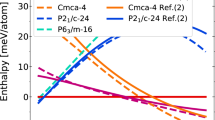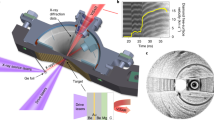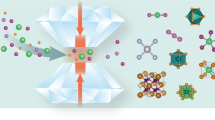Abstract
Studying materials at terapascal (TPa) pressures will provide insights into the deep interiors of large planets and chemistry under extreme conditions1,2. The equation of state of aluminium is of interest because it is used as a standard material in shock-wave experiments and because it is a typical s p-bonded metal1,3. Here we use density-functional-theory methods and a random-searching approach to predict stable structures of aluminium at multiterapascal pressures, finding that the low-pressure close-packed structures transform to more open structures above 3.2 TPa (nearly ten times the pressure at the centre of the Earth), with an incommensurate host–guest structure being stable over a wide range of pressures and temperatures. We show that the high-pressure phases may be described by a two-component model consisting of positive ions and interstitial electron ‘blobs’, and propose that such structures are common in s p-bonded materials up to multiterapascal pressures.
This is a preview of subscription content, access via your institution
Access options
Subscribe to this journal
Receive 12 print issues and online access
$259.00 per year
only $21.58 per issue
Buy this article
- Purchase on Springer Link
- Instant access to full article PDF
Prices may be subject to local taxes which are calculated during checkout



Similar content being viewed by others
References
Jeanloz, R. et al. Achieving high-density states through shock-wave loading of precompressed samples. Proc. Natl Acad. Sci. USA 104, 9172–9177 (2007).
Hawreliak, J. et al. Modeling planetary interiors in laser based experiments using shockless compression. Astrophys. Space Sci. 307, 285–289 (2007).
Batani, D. et al. Equation of state data for iron at pressures beyond 10 Mbar. Phys. Rev. Lett. 88, 235502 (2002).
Lomonosov, I. V. Multi-phase equation of state of aluminum. Laser Particle Beams 25, 567–584 (2007).
Vladimirov, A. S., Voloshin, N. P., Nogin, V. N., Petrovtsev, A. V. & Simonenko, V. A. Shock compressibility of aluminum. Sov. Phys. JETP Lett. 39, 85–88 (1984).
Akahama, Y., Nishimura, M., Kinoshita, K. & Kawamura, H. Evidence of a fcc–hcp transition in aluminum at multimegabar pressure. Phys. Rev. Lett. 96, 045505 (2006).
Tambe, M. J., Bonini, N. & Marzari, N. Bulk aluminum at high pressure: A first-principles study. Phys. Rev. B 77, 172102 (2008).
Pickard, C. J. & Needs, R. J. High pressure phases of silane. Phys. Rev. Lett. 97, 045504 (2006).
Pickard, C. J. & Needs, R. J. Structure of phase III of hydrogen. Nature Phys. 3, 473–476 (2007).
Pickard, C. J. & Needs, R. J. Highly compressed ammonia forms an ionic crystal. Nature Mater. 10, 757–779 (2008).
Pickard, C. J. & Needs, R. J. Dense low-coordination phases of lithium. Phys. Rev. Lett. 102, 146401 (2009).
Fortes, A. D., Suard, E., Lemé-Cailleau, M-H., Pickard, C. J. & Needs, R. J. Crystal structure of ammonia monohydrate II. J. Am. Chem. Soc. 131, 13508–13515 (2009).
Nelmes, R. J., Allan, D. R., McMahon, M. I. & Belmonte, S. A. Self-hosting incommensurate structure of barium IV. Phys. Rev. Lett. 83, 4081–4084 (1999).
McMahon, M. I. & Nelmes, R. J. High-pressure structures and phase transformations in elemental metals. Chem. Soc. Rev. 35, 943–963 (2006).
Arapan, S., Mao, H-k. & Ahuja, R. Prediction of incommensurate crystal structure in Ca at high pressure. Proc. Natl Acad. Sci. USA 105, 20627–20630 (2008).
Brazhkin, V. V. High-pressure synthesized materials: A chest of treasure and hints. High Pressure Res. 27, 333–351 (2007).
Holian, K. S. A new equation of state for aluminum. J. Appl. Phys. 59, 149–157 (1986).
Rousseau, B. & Ashcroft, N. W. Interstitial electronic localization. Phys. Rev. Lett. 101, 046407 (2008).
Neaton, J. B. & Ashcroft, N. W. Pairing in dense lithium. Nature 400, 141–144 (1999).
Jones, H. Applications of the Bloch theory to the study of alloys and of the properties of bismuth. Proc. R. Soc. A 147, 396–417 (1934).
Ackland, G. J. & Macleod, I. R. Origin of the complex crystal structures of elements at intermediate pressure. New J. Phys. 6, 138 (2004).
Von Schnering, H. G. & Nesper, R. How nature adapts chemical structures to curved surfaces. Angew. Chem. 26, 1059–1080 (1987).
Ma, Y. M. et al. Transparent dense sodium. Nature 458, 182–185 (2009).
Lundegaard, L. F. et al. Single-crystal studies of incommensurate Na to 1.5 Mbar. Phys. Rev. B 79, 064105 (2009).
Clark, S. J. et al. First principles methods using CASTEP. Z. Kristallogr. 220, 567–570 (2005).
Vanderbilt, D. Soft self-consistent pseudopotentials in a generalized eigenvalue formalism. Phys. Rev. B 41, 7892–7895 (1990).
Perdew, J. P., Burke, K. & Ernzerhof, M. Generalized gradient approximation made simple. Phys. Rev. Lett. 77, 3865–3868 (1996).
Acknowledgements
The authors were supported by the Engineering and Physical Sciences Research Council (EPSRC) of the UK.
Author information
Authors and Affiliations
Contributions
C.J.P. and R.J.N. contributed extensively to all aspects of the work.
Corresponding author
Supplementary information
Supplementary Information
Supplementary Information (PDF 1031 kb)
Supplementary Information
Crystallographic information for Al1-P6mmm at 10 TPa (CIF 0 kb)
Supplementary Information
Crystallographic information for Al4-Cmma at 20 TPa (CIF 1 kb)
Supplementary Information
Crystallographic information for Al11-P-1 at 5TPa (CIF 1 kb)
Supplementary Information
Crystallographic information for Al16-B2n at 5TPa (CIF 1 kb)
Supplementary Information
Crystallographic information for Al16-I4mcm at 5TPa (CIF 1 kb)
Supplementary Information
Crystallographic information for Al21-P1 at 5TPa (CIF 2 kb)
Supplementary Information
Crystallographic information for Al22-P4mbm at 5TPa (CIF 1 kb)
Supplementary Information
Crystallographic information for Al40-P4mnc at 5TPa (CIF 1 kb)
Supplementary Information
Crystallographic information for Al42-P4mnc at 5TPa (CIF 1 kb)
Supplementary Information
Crystallographic information for Al46-P4mbm at 5TPa (CIF 3 kb)
Supplementary Information
Crystallographic information for Al86-P4212 at 5TPa (CIF 2 kb)
Rights and permissions
About this article
Cite this article
Pickard, C., Needs, R. Aluminium at terapascal pressures. Nature Mater 9, 624–627 (2010). https://doi.org/10.1038/nmat2796
Received:
Accepted:
Published:
Issue Date:
DOI: https://doi.org/10.1038/nmat2796
This article is cited by
-
Single-shot X-ray absorption spectroscopy at X-ray free electron lasers
Scientific Reports (2023)
-
Experimental observation of open structures in elemental magnesium at terapascal pressures
Nature Physics (2022)
-
Interspecies radiative transition in warm and superdense plasma mixtures
Nature Communications (2020)
-
Chemistry under high pressure
Nature Reviews Chemistry (2020)
-
Ferromagnetic quasi-atomic electrons in two-dimensional electride
Nature Communications (2020)



